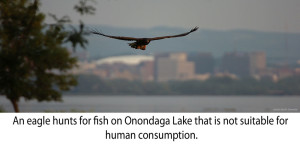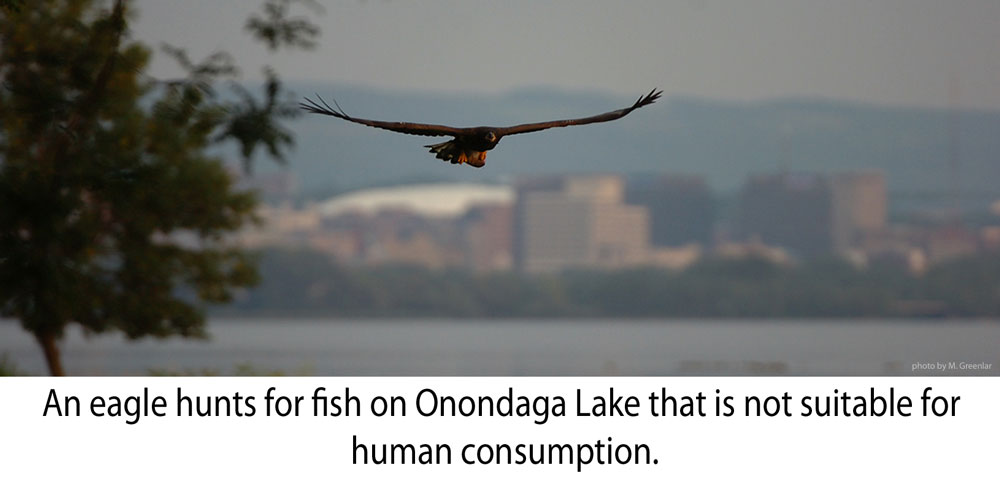
OnondagaNation.org
January 14, 2015
Onondaga Nation- The region of Onondaga Lake and the Onondaga Lake watershed has been the homeland of the Onondaga since the dawn of time. The Onondaga have been the trustee and steward of Onondaga Lake since time immemorial and will continue to do so forever, as that is what has been mandated from the Gayanashagowa, the Great Law of Peace. In the 1794 Treaty of Canandaigua, the United States government recognized Onondaga Lake as part of our aboriginal territory.
The Lake is the spiritual, cultural and historic center of the Haudenosaunee Confederacy. Over one thousand years ago, the Peacemaker brought the Mohawk, Oneida, Onondaga, Cayuga, and Seneca Nations together on the shores of Onondaga Lake. At the Lakeshore, these warring Nations accepted the message of peace, laid down their arms, and formed the Haudenosaunee Confederacy. The Confederacy was the first representative democracy in the West.
To symbolize the Confederacy, the Peacemaker chose a white pine, the Tree of Peace. The Peacemaker chose the white pine because the white pine’s needles are clustered in groups of five, just as the five founding Nations of the Confederacy clustered together for strength. The boughs of the white pine represent the laws that protect all the people. An eagle was placed at the top of the tree to watch for danger from without and within. Four white roots of peace reach out in the four directions towards anyone or any Nation who wishes to come under this tree of peace.
Today, the eagle is sending us its warning. On November 3, 2014, Honeywell announced with Onondaga County and NYSDEC representatives that it is “done” dredging out the pollution from Onondaga Lake. No one from the Onondaga Nation was present at this ‘celebration.’
The Contaminants
As the birthplace of the Confederacy and democracy, the Lake is sacred to the Haudenosaunee. Sitting on the bottom of that sacred lake is a lot of pollution: and most notably, a whole lot of mercury. Honeywell and its predecessor companies released an estimated 165,000 lbs. of mercury into Onondaga Lake. Most of it is still there, along with polychlorinated biphenyls (PCBs); pesticides; creosotes; other heavy metals including lead, and cobalt; polycyclic aromatic hydrocarbons (PAHs); and volatile organic compounds (VOCs) such as chlorobenzene.
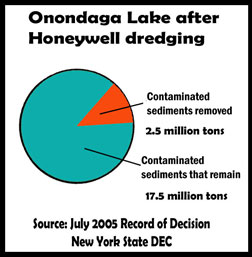 “Honeywell plans to leave more than 80% of the contaminated sediments at the bottom of the lake,” said General Counsel to the Onondaga Nation Joseph Heath. “The amount of waste that we are leaving for our children to deal with is incomprehensible.”
“Honeywell plans to leave more than 80% of the contaminated sediments at the bottom of the lake,” said General Counsel to the Onondaga Nation Joseph Heath. “The amount of waste that we are leaving for our children to deal with is incomprehensible.”
The Onondaga Nation has voiced its concerns about the remedy since it was first proposed. Experts were hired to comment on it, to call attention to the way it averaged contaminant concentrations in order to select the areas which would be dredged. In this way, some “hot spots” would go unaddressed. These comments were ignored.
Since 2005 when the decision was made to dredge part of the Lake bottom and to cap other parts of it, only small token advancements have been made. Regulators have provided the Onondaga Nation with ongoing information and volumes and volumes of documents.
“Most of the Onondaga Nation’s comments have been ignored,” added General Counsel Joseph Heath. “Some small changes have been made, like planting native plants on the reclaimed sites. But no additional waste has been removed from the Lake.”
The Onondaga Nation has resided on the Lake, building homes and communities, fishing, hunting, trapping, collecting plants and medicine, planting agricultural crops, performing ceremonies with the natural world dependent on the Lake. The mothers, fathers and children of the Onondaga Nation have a deep history to those waters.
“We are forever tied to the Lake and the land around it,” said Tadodaho Sid Hill. “The Onondaga Nation views its relationship to this area as a place where we will forever be tied to. We are just asking that it be returned in its natural state, not a superfund site.”
The Lake has given a lot
In the 1600’s the Onondaga’s showed the early French explorers the salt marshes located along its shoreline. The late 1700’s saw the birth of a new country called the United States and a new industry, salt production. Soon the lake shore was dotted with salt blocks which were large factories built to boil away the salt brine to make salt. By the 1860s the Lake was providing more than a million of bushels of salt and gave birth to a nickname of the city of Syracuse, the Salt City.
By the beginning of the 1900’s scientists and entrepreneurs created the Solvay process. This process proved to be deadly to the health of the Lake. The process used the salt brine to create soda ash which is a major component to make glass. With each new business, Onondaga Lake became a convenient place for the industrial waste to be placed. By 1940, the Lake was no longer suited for swimming, fishing, or drinking. Today, the Onondaga Lake is 40% smaller from the time of forming of the Great Peace on its shores among the Mohawk, Oneida, Onondaga, Cayuga and Seneca Nations. 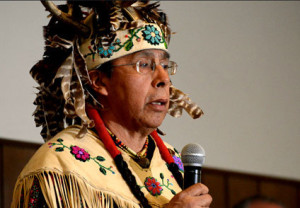
“It brings great sadness to the people of the Onondaga Nation that despite our long stewardship of the Lake and its watershed, it took only one hundred years of abuse to wreak havoc to the Lake,” said Sid Hill. “The Lake’s tributaries, plants, animals, and marine life that depend on the Lake have been so badly damaged.”
The Consultation
In 1999, Honeywell (formerly Allied Chemical) was mandated to work with the NYSDEC on the superfund known as Onondaga Lake. Honeywell and the NYSDEC know of the Onondaga Nation’s close relationship to the lake. Honeywell was therefore instructed to consult with the Onondaga Nation on a remedy.
“The lawyers from DEC came to the longhouse,” recalls Sid Hill. “We were ready to sit and begin our consultation. DEC informed us that there will be a press conference the following day stating that they had selected the best remedy for the lake. We were shocked that the DEC didn’t try to fight to clean the Lake, and that both the DEC and Honeywell considered informing us of their upcoming press conference as consultation.”
Despite Honeywell’s consistently high profitability, for example their third quarter 2014 sales were reported as $10.1 billion and increased shareholder dividends; the company only agreed to spend 451 million dollars on the remedy. Honeywell agreed to remove 2.5 million cubic yards of contaminated sludge out of the lake, build a retaining wall to try to hold back more contaminates from steeping into the lake, and provide a ‘protective’ layer of sand on the lake bottom. But since that 2005 agreement, Honeywell requested and was granted permission not to dredge in one contaminated area because of fear of destabilizing the adjacent railroad tracks and shoreline.
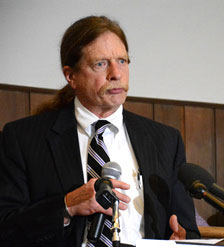 “To remove all of the mercury and contaminates from Onondaga Lake, it would have required dredging about 20 million cubic yards of sediment.” added Heath. “We are leaving over 17 million tons of pollution in the Lake for our children to deal with.”
“To remove all of the mercury and contaminates from Onondaga Lake, it would have required dredging about 20 million cubic yards of sediment.” added Heath. “We are leaving over 17 million tons of pollution in the Lake for our children to deal with.”
So on November 3, 2014, the Onondaga Nation was not present or invited to the celebration of the early completion of dredging by Honeywell. The Onondaga Nation feels there is so much more that needs to be done.
“We are one with this land and this Lake,” said Hill. “It is our duty to work for a healing of this land, its waters and living things, to protect it, and to pass it on to future generations – yours and ours.”

